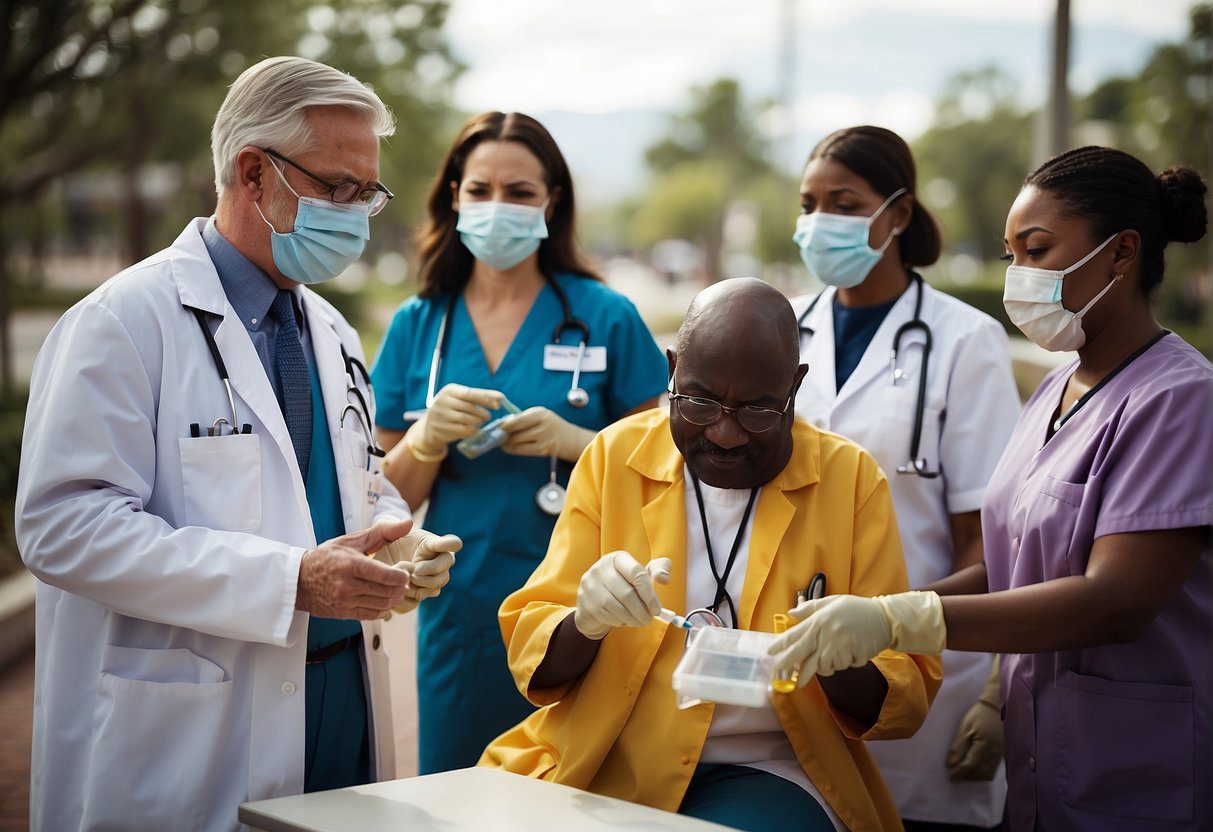Primary prevention in preventive medicine is a proactive approach focusing on the prevention of disease before it occurs. By addressing risk factors and bolstering health-defining behaviors and environments, primary prevention aims to reduce the incidence of illness within the population.
This foundational facet of preventive medicine encompasses a wide array of activities—from immunizations to lifestyle modifications aimed at preventing heart disease, diabetes, and various cancers.

Within primary prevention, strategies are employed to keep healthy individuals—regardless of their perceived risk—free from disease. Education on nutritious diets, the importance of regular physical activity, and the avoidance of tobacco and excessive alcohol use are some common examples. However, primary prevention not only pertains to individual behaviors but extends to broader interventions, like reducing air pollution or improving access to healthy foods, which have a far-reaching impact on public health.
Key Takeaways
- Primary prevention in preventive medicine proactively reduces disease incidence by addressing health behaviors and environments.
- It includes individual initiatives like immunizations and lifestyle changes, as well as public health measures that benefit communities at large.
- Effective primary prevention strategies improve overall population health while aiming to prevent the emergence of disease risk factors.
Fundamentals of Preventive Medicine

Preventive medicine operates on the premise that it is better to prevent diseases than to treat them after they occur. This medical field focuses on maintaining health and well-being through proactive measures.
Principles of Preventive Medicine
Preventive medicine encompasses health promotion and disease prevention strategies to reduce the incidence of diseases. This discipline utilizes a three-tiered approach: primary, secondary, and tertiary prevention. Primary prevention aims to prevent the onset of disease by controlling risk factors and enhancing resistance to disease. Strategies include immunization, healthy lifestyle promotion, and environmental modifications. Secondary prevention involves early detection and intervention, such as screening tests to identify diseases in their initial stages. Tertiary prevention focuses on mitigating the impact of established diseases by restoring function and reducing disease-related complications.
Roles of Preventive Medicine Physicians
Physicians specializing in preventive medicine play a crucial role in safeguarding community health. They devise and manage preventive health care programs that address the population’s needs. They work in various settings, from hospitals to community health organizations, applying their expertise to control and prevent health problems. Their responsibilities also involve educating the public on health maintenance and disease prevention, which includes advocating for healthy behaviors and environments conducive to good health. Their clinical work may often intersect with fields such as occupational health, public health policy, and health services research, aiming to create an overall healthier society.
Primary Prevention Strategies

Primary prevention strategies are critical to reducing the incidence of disease by mitigating risk factors before they result in illness. They encompass a wide range of activities, including health education, public health policies, and vaccination programs, all designed to protect and improve community health.
Education and Health Promotion
Health education aims to provide individuals with the knowledge and skills necessary to make healthy choices. Programs targeting smoking cessation or the initiation of an exercise regimen are classic examples of education and health promotion in action. The effectiveness of such programs is well-documented in the literature, such as in studies on smoking where qualitative methods have significantly contributed to primary prevention research.
Public Health Policies and Recommendations
Public health policies are essential for implementing community-wide health interventions. These policies can dictate the availability of resources for primary prevention and often include recommendations for healthy living. An example is the dietary and lifestyle advice for the primary prevention of coronary heart disease in women.
Immunization Programs
Immunization programs represent a cornerstone of primary prevention. They prevent the spread of infectious diseases by protecting individuals before they are exposed to pathogens. Immunizations are a cost-effective means of primary prevention, often preventing morbidity and mortality on a global scale. The role of immunizations in primary preventive medicine is supported by position statements from authoritative organizations, which can be found in resources such as the American College of Preventive Medicine.
Targeting High-Risk Populations
Targeting high-risk populations involves strategic approaches to prevent disease before it occurs, primarily by identifying and providing interventions for individuals with heightened risk factors. Screening protocols and preventive services are critical components in this effort.

Screening for Common Diseases
Screenings are pivotal for the early detection of breast cancer, cervical cancer, and colorectal cancer. Risk factors for these diseases can include lifestyle choices, genetic predisposition, and age. Regular screening tests, such as mammograms for breast cancer and colonoscopies for colorectal cancer, are advised for populations identified at high risk.
Recommended Screenings for Adults:
- Breast Cancer: Mammograms every 1-2 years for women starting at age 50.
- Cervical Cancer: Pap tests every 3 years for women aged 21-65.
- Colorectal Cancer: Colonoscopy every 10 years starting at age 50.
Breast and cervical cancer screenings are less commonly performed in men, but those with specific risk factors may require evaluation.
Preventive Services for Children and Adolescents
Preventative services in pediatrics aim to address risk factors in youth that could impact their health into adulthood. These include screenings for conditions like hypertension and hypercholesterolemia, which can have lifelong consequences if not managed early.
Preventive Services for Pediatrics:
- Hypertension Screening: Annual blood pressure checks.
- Cholesterol Screening: Testing for those with a family history of early heart disease.
Vaccinations also form a cornerstone of pediatric preventive services, protecting against a range of preventable diseases.
Preventive Services for Adults
For adults, preventive services expand to include screenings for chronic conditions prevalent in this age group. Monitoring blood pressure and cholesterol levels is essential to reducing the risk of cardiovascular diseases.
Key Adult Screenings Include:
- Hypertension: Regular blood pressure screenings.
- Cholesterol: Lipid profiles every 4-6 years, or more frequently if risk factors are present.
Lifestyle interventions and counseling on proper diet and exercise are also part of preventive care for adults, designed to mitigate risk factors and maintain overall health.
Lifestyle and Behavior Interventions

Lifestyle and behavior interventions are critical components in the primary prevention of various diseases. They target modifiable factors such as diet, physical activity, and substance use to promote overall health and well-being.
Nutrition and Physical Activity
Nutrition and physical activity are the cornerstones of maintaining a healthy weight and reducing the risk of chronic diseases like obesity and type 2 diabetes. Physical activity, particularly aerobic exercises such as walking, running, or cycling, is essential for cardiovascular health and aids in weight management. Regular exercise supports metabolic functions and improves mood and stress levels. Nutrition-wise, a diet rich in fruits, vegetables, whole grains, and lean proteins is recommended to prevent cancer. For instance, following the AHA guidelines for primary prevention can reduce cardiovascular disease by promoting a healthy diet and exercise guidelines.
Substance Abuse Prevention
Substance abuse, including smoking and alcohol consumption, can lead to a range of health issues, from lung cancer to liver diseases. Interventions often focus on education, cessation programs, and community support networks to address these addictive behaviors. For instance, comprehensive smoke-free laws and policies are an effective way to deter the initiation of smoking. In the context of alcohol, moderation is key, and behavioral interventions aim to reduce the risks associated with excessive consumption, such as dependency and accidents.
Mental Health and Stress Management
Mental health and stress management are integral to maintaining a balanced lifestyle. Psychological stress is known to contribute to physical health problems, such as hypertension and poor immune function. Techniques for managing stress include mindfulness, therapy, and relaxation exercises. More comprehensive behavioral risk factor interventions delivered in primary care help to improve psychological well-being, which in turn can contribute to healthier lifestyle choices and enhance the effectiveness of other prevention strategies.
Clinical Preventive Services

Clinical preventive services are critical interventions in preventive medicine, employing strategies like screening and counseling to mitigate health issues before they arise. These services are frequently guided by recommendations from authoritative bodies such as the U.S. Preventive Services Task Force (USPSTF).
Evidence-Based Screening Recommendations
Screening is a cornerstone of clinical preventive services, with the aim of identifying risk factors or undetected diseases in asymptomatic individuals. The USPSTF provides evidence-based recommendations for various screenings, prioritizing those that offer substantial benefits. For instance, screenings for hypertension and diabetes are recommended for adults due to the high prevalence and potential complications of these conditions. Hypercholesterolemia screening is also crucial in the prevention of cardiovascular diseases. Additionally, for older women, screening for osteoporosis helps in preventing fractures. These recommendations are based on rigorous review of existing studies to ensure efficacy and safety.
Counseling and Education Services
In preventive medicine, counseling and educational services play significant roles. They focus on promoting healthy behaviors and preventing the onset of chronic conditions. For instance, counseling sessions might be employed to support individuals at risk for diseases like depression and diabetes, assisting them in understanding their conditions and the importance of lifestyle modifications. Tailored education on nutrition and physical activity is often provided to prevent obesity and related complications.
Chemoprophylaxis and Medications
Chemoprophylaxis refers to the use of medications to prevent disease. In the domain of clinical preventive services, this often involves providing medications to at-risk populations to avert the onset of disease. For example, the USPSTF may recommend low-dose aspirin for certain individuals to prevent cardiovascular disease. Medications for hypercholesterolemia can significantly reduce the risk of heart attacks when prescribed based on a patient’s individual risk assessment.
Each of these components of clinical preventive services — screening, counseling, and chemoprophylaxis — contribute to a proactive approach in healthcare, aiming to improve patient outcomes through prevention.
Management of Preventive Medicine

Effective management of preventive medicine within primary care involves the systematic integration of preventive services and the pivotal role played by nursing and allied health professionals. Strategic coordination and deployment of preventive health measures can enhance patient outcomes and promote long-term health.
Integration of Preventive Services in Primary Care
Primary care is the frontline in the delivery of preventive medicine, with clinicians adopting evidence-based guidelines to identify and mitigate health risks before they escalate. The successful integration of these services demands careful planning and adherence to protocols that screen for potential health issues. An effective strategy may involve:
- Systematic screenings: Routine assessments for conditions like hyperlipidaemia.
- Lifestyle counseling: Guidance on physical activity and nutrition to prevent chronic diseases.
- Immunizations: Administration of vaccines as a form of primary prevention.
Role of Nursing and Allied Health Professionals
Nursing and allied health professionals play a critical role in executing preventive health measures. Their expertise in patient education and their constant patient interaction position them uniquely to carry out these tasks. Key contributions include:
- Patient Education: Nurses often lead patient education efforts, informing individuals on how to maintain a healthy lifestyle and prevent disease.
- Care Coordination: They ensure continuity of preventive care, from initial screenings to follow-up interventions.
- Community Outreach: Allied health professionals often engage in community programs aimed at promoting general health and preventing disease, such as organizing health fairs or educational workshops.
Both nursing and allied health professionals collaborate closely with primary care clinicians to create a comprehensive and cohesive approach to disease prevention. This teamwork is integral to the overall management of preventive medicine within primary care settings.
Challenges and Considerations in Prevention

Effective prevention in preventive medicine is pivotal, yet it does face specific challenges that require careful consideration to ensure that interventions are both efficient and ethical.
Overmedicalization and Resource Allocation
Overmedicalization occurs when medical interventions are expanded to the realm of normal human experiences, sometimes leading to excessive diagnostic testing or medical treatments where they may not be necessary. Preventive medicine must balance the risks of overmedicalization with the potential benefits of early detection and treatment. Resource allocation becomes a challenge, as healthcare systems must prioritize which preventive measures to fund while avoiding the unnecessary medicalization of health issues that could be managed through simpler, non-medical means.
Communication and Misinformation
Clear and accurate communication of health information is critical for the success of preventive strategies. Misinformation can undermine public health efforts, leading to poor health choices and reduced trust in healthcare systems. It is necessary for health professionals to not only share evidence-based information but also to counteract misinformation effectively and compassionately, tailoring messages in ways that resonate with diverse audiences.
Ethical and Cultural Considerations
Ethical dilemmas frequently arise in preventive medicine. Actions that are beneficial from a public health perspective, such as vaccinations or screening programs, may clash with individual autonomy. Cultural considerations also play a significant role, as beliefs and practices regarding health and preventative care vary widely across different populations. Respecting these differences and integrating cultural competence into preventive strategies can help to ensure that interventions are sensitive, respectful, and widely accepted.
Future Directions in Preventive Medicine

Preventive medicine is evolving rapidly due to advances in medical research and technology. The field stands on the cusp of significant innovations that aim to enhance primary prevention strategies and improve public health outcomes.
Research and Development
Current trends in preventive medicine research focus on understanding the multifaceted causes of diseases to develop more effective prevention strategies. For instance, research into occupational health psychology is evolving to better manage organizational demands and mitigate chronic occupational health problems. The integration of psychological principles in the workplace is pivotal for primary prevention and overall wellbeing.
Collaboration with National Experts
The collaboration with national experts is vital for disseminating and implementing the latest prevention techniques. Experts across various medical disciplines are joining forces to form interdisciplinary teams that create comprehensive preventive programs. Collaboration yields a synthesis of knowledge, leading to innovative strategies—such as life skills training programs—that address risk and protective factors associated with adolescent drug abuse.
Advancements in Health Technologies
Technological innovation is playing a critical role by introducing new tools for chronic disease prevention in children and adults alike. The implementation of digital health platforms facilitates the promotion of healthy behaviors and magnifies the reach of primary prevention programs. Health technologies, including mobile health apps and telemedicine, empower individuals to take proactive roles in managing their health and facilitate remote patient monitoring to preempt disease progression.
Frequently Asked Questions

In the realm of healthcare, effective primary prevention forms the cornerstone of combating diseases before they emerge. It aims to shield individuals from developing health conditions through proactive measures.
What are the main objectives of primary prevention in healthcare?
The main objectives of primary prevention are to reduce the incidence of disease, eliminate risk factors, and enhance overall health and quality of life.
How do primary prevention strategies differ from secondary prevention measures?
Primary prevention strategies focus on preventing diseases from occurring in the first place, while secondary prevention measures aim to detect and treat diseases early in their progression.
Can you list common practices used in primary prevention?
Common practices in primary prevention include immunizations, healthy diet promotion, regular physical activity, and tobacco cessation efforts.
Why is primordial prevention considered a subset of primary prevention?
Primordial prevention is a subset of primary prevention because it focuses on averting the development of risk factors that contribute to chronic conditions.
In what ways do primary prevention methods contribute to public health?
Primary prevention methods contribute significantly to public health by lowering the prevalence of diseases, thereby reducing the burden on healthcare systems and improving community well-being.
How does lifestyle modification fit into primary prevention efforts?
Lifestyle modification is integral to primary prevention efforts as it includes changes such as adopting a balanced diet, engaging in physical exercise, and avoiding harmful behaviors like smoking.